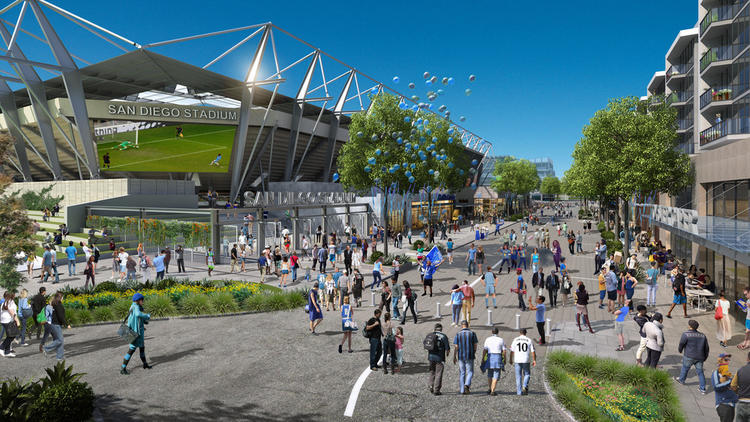When San Diego voters head to the polls on Tuesday, they will consider SoccerCity, a proposed development at the SDCUU Stadium site anchored by a new soccer-specific venue, as well as a proposal for an SDSU campus expansion that includes a new stadium that could potentially serve as an MLS home. Those referendums are key to the city’s MLS expansion hopes–but the final form of any bid remains to be seen.
As first unveiled in 2017, SoccerCity is a proposal from FS Investors to redevelop the SDCCU Stadium (formerly Qualcomm Stadium) site in Mission Valley and factors into San Diego’s MLS expansion bid. It calls for a stadium that would be constructed for an MLS club, along with surrounding development. FS Investors would enter into a 99-year lease with the city for 233 acres at the stadium site, plus 20 acres at the Chargers’ former training facility in Murphy Canyon.
In the period since it was unveiled, SoccerCity has had a few twists and turns. Backers sought to get it on the ballot as part of a special election last year, only for city officials to hold off on a referendum until 2018. Furthermore, a plan to work in partnership with San Diego State University–whose football program plays at SDCCU Stadium–did not come to fruition after the two sides failed to come to an agreement.
That led to the Friends of SDSU group presenting its own plan for the site, SDSU West. It calls for development that includes a new outpost for SDSU, with the stadium in its plan designed to accommodate SDSU football and professional soccer. In addition, the stadium would be capable of expanding from 35,000 seats to 55,000 seats in the event that it becomes home to an NFL franchise.
In a few respects, the proposals are very similar. Both target the same site for a new stadium/mixed-use development concept, propose constructing a new river park, and account for the NFL’s potential return to the city (SoccerCity sets aside 16 acres, for a period of five years, that could be used for a new football stadium).
Yet, the two proposals may have completely different implications for San Diego’s MLS hopes. While the SDSU stadium will be designed to host professional soccer and be expandable for NFL football, it is not attached to a specific MLS expansion bid in the way that SoccerCity is. MLS has also been mum to this point about what will become of San Diego’s hopes if SoccerCity is rejected, which is perhaps not surprising given the number of unanswered questions surrounding the next round of expansion.
With the move of the NFL’s Chargers leaving a void in the city’s sports scene, San Diego was viewed in many respects as a strong contender when MLS launched a round of expansion in early 2017. However, the timing of the referendum and combination of other factors–including rising bids in cities like Cincinnati, Detroit, Nashville, and Sacramento–meant that San Diego was left out when the league considered four finalists late last year. Nashville and later Cincinnati were selected from that group, but MLS is still left with plenty of strong options. Detroit has some promise despite its recent announcement that it will not retrofit Ford Field with a retractable roof, while Phoenix continues to build momentum at a steady pace. St. Louis has also seen its hopes revived thanks to a new bid, and Austin may end up with an expansion team if plans to keep the Crew in Columbus come to fruition.
In other words, MLS will have plenty of variables to consider beyond the outcome of Tuesday’s election. With both SoccerCity and SDSU West on the ballot, the proposal with the greatest share of majority voter approval will move forward. Voters are not obligated to approve either option, however, and could in theory reject both ballot questions and ultimately make the city seek alternative plans for the land. SDSU West had a comfortable lead over SoccerCity in the polls as of mid-October, but it remains to be seen how the election will play out.

